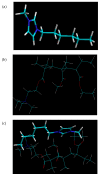An Imidazolium-Based Ionic Liquid as a Model to Study Plasticization Effects on Cationic Polymethacrylate Films
- PMID: 36904480
- PMCID: PMC10006978
- DOI: 10.3390/polym15051239
An Imidazolium-Based Ionic Liquid as a Model to Study Plasticization Effects on Cationic Polymethacrylate Films
Abstract
Ionic liquids (ILs) have been touted as effective and environmentally friendly agents, which has driven their application in the biomedical field. The study compares the effectiveness of an IL agent, 1-hexyl-3-methyl imidazolium chloride ([HMIM]Cl), to current industry standards for plasticizing a methacrylate polymer. Industrial standards glycerol, dioctyl phthalate (DOP) and the combination of [HMIM]Cl with a standard plasticizer was also evaluated. Plasticized samples were evaluated for stress-strain, long-term degradation, thermophysical characterizations, and molecular vibrational changes within the structure, and molecular mechanics simulations were performed. Physico-mechanical studies showed that [HMIM]Cl was a comparatively good plasticizer than current standards reaching effectiveness at 20-30% w/w, whereas plasticizing of standards such as glycerol was still inferior to [HMIM]Cl even at concentrations up to 50% w/w. Degradation studies show HMIM-polymer combinations remained plasticized for longer than other test samples, >14 days, compared to glycerol <5 days, while remaining more pliable. The combination of [HMIM]Cl-DOP was effective at concentrations >30% w/w, demonstrating remarkable plasticizing capability and long-term stability. ILs used as singular agents or in tandem with other standards provided equivalent or better plasticizing activity than the comparative free standards.
Keywords: green chemistry; ionic liquids; mechanical properties; plasticization; polymeric films; stress/strain properties.
Conflict of interest statement
The authors declare no conflict of interest.
Figures









References
-
- Pei Y., Zhang Y., Ma J., Fan M., Zhang S., Wang J. Ionic liquids for advanced materials. Mater. Today Nano. 2022;17:100159. doi: 10.1016/j.mtnano.2021.100159. - DOI
-
- Fitriani F., Bilad M.R., Aprilia S., Arahman N. Biodegradable hybrid polymer film for packaging: A review. J. Nat. Fibers. 2023;20:2159606. doi: 10.1080/15440478.2022.2159606. - DOI
-
- Elanjeitsenni V.P., Vadivu K.S., Prasanth B.M. A review on thin films, conducting polymers as sensor devices. Mater. Res. Express. 2022;9:022001. doi: 10.1088/2053-1591/ac4aa1. - DOI
-
- Braun D., Cherdron H., Rehahn M., Ritter H., Voit B. Polymer Synthesis: Theory and Practice Fundamentals, Methods, Experiments. Springer; Heidelberg, Germany: 2013. pp. 352–353.
Grants and funding
LinkOut - more resources
Full Text Sources

